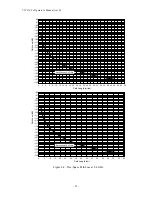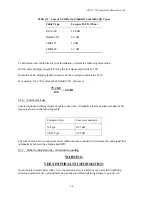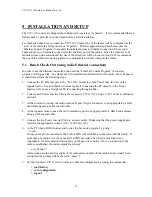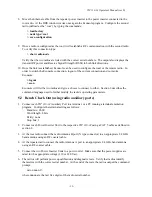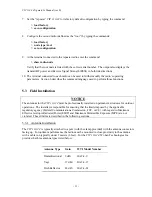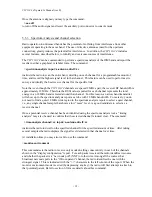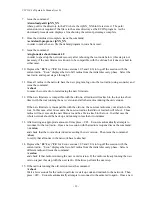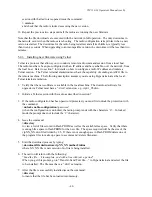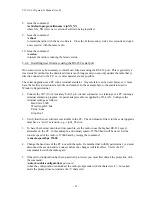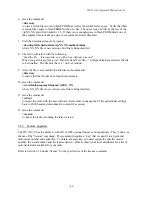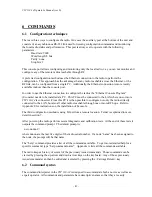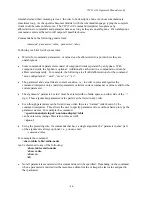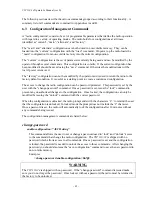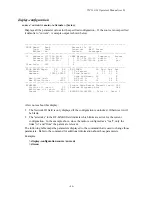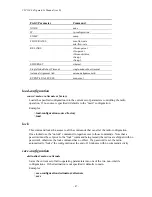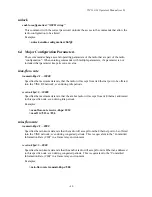
VIP 110-24
Operator’s Manual (rev E)
- 35 -
Once the antenna is aligned you may type the command:
>aaa off
to turn off the audio signal and revert the auxiliary port connector to console mode.
5.3.3
Spectrum Analysis and channel selection
Radio operation in unlicensed bands has the potential of suffering from interference from other
equipment operating in the same band. The use of directive antennas (used for the upstream
connection), greatly reduces the potential for interference. In addition, the
VIP 110-24
includes
several features, described below, to identify and overcome sources of interference.
The
VIP 110-24
can be commanded to perform a spectrum analysis of the ISM band and report the
results in either a graphical or tabular form. The command:
>
spectrum-analysis input=a-antenna dwell=xx
instructs the radio to scan the entire band, dwelling on each channel for a programmable amount of
time, and record the highest signal level in that channel. This feature can be used to perform a site
survey and identify the best receive channel for the specific link.
Note that even though the
VIP 110-24
channels are spaced 2 MHz apart, the receiver RF bandwidth is
approximately 18 MHz. Therefore the RSSI value reported for each channel represents the total
energy in an 18 MHz band centered around that channel. For this reason, a narrow band transmitter
will show up in the spectrum analysis report as a lobe with 18 MHz bandwidth. Conversely, you do
not need to find a quiet 18 MHz wide region in the spectrum analysis report to select a quiet channel,
i.e., any single channel sample that shows a low “noise” level, is a good candidate to select a s a
receive channel.
Once a potential receive channel has been identified using the spectrum analysis tool, a “timing
analysis” may also be used to confirm that the selected channel is indeed clear. The command:
>time-analysis channel=xx input=a-antenna dwell=xx
instructs the radio to dwell on the specified channel for the specified amount of time. After taking
several samples the radio displays the signal level detected in that channel over time.
At installation time you may also want to use the command:
>
monitor-environment
This command sets the radio in receive only mode dwelling consecutively in each of the channels
shown in the “display configuration” report. For each packet received the radio identifies its source
and whether the packet is a “new node poll” (NNP) or otherwise. Among all the sources that
broadcast new node polls in the “rf-from-parent” channel, the radio identifies the one with the
strongest signal. This is indicated with the “>>” characters in the left column of the report. When the
monitor environment mode is exited (by depressing any key), the radio will first attempt to attach to
that potential parent. Refer to section 6 for more details about this command.
Summary of Contents for VIP 110-24
Page 2: ......
Page 5: ...VIP 110 24 Operator s Manual rev E iv...
Page 37: ...VIP 110 24 Operator s Manual rev E 30...
Page 73: ...VIP 110 24 Operator s Manual rev E 66...
Page 89: ...VIP 110 24 Operator s Manual rev E 82...
Page 91: ...VIP 110 24 Operator s Manual rev E 84...





